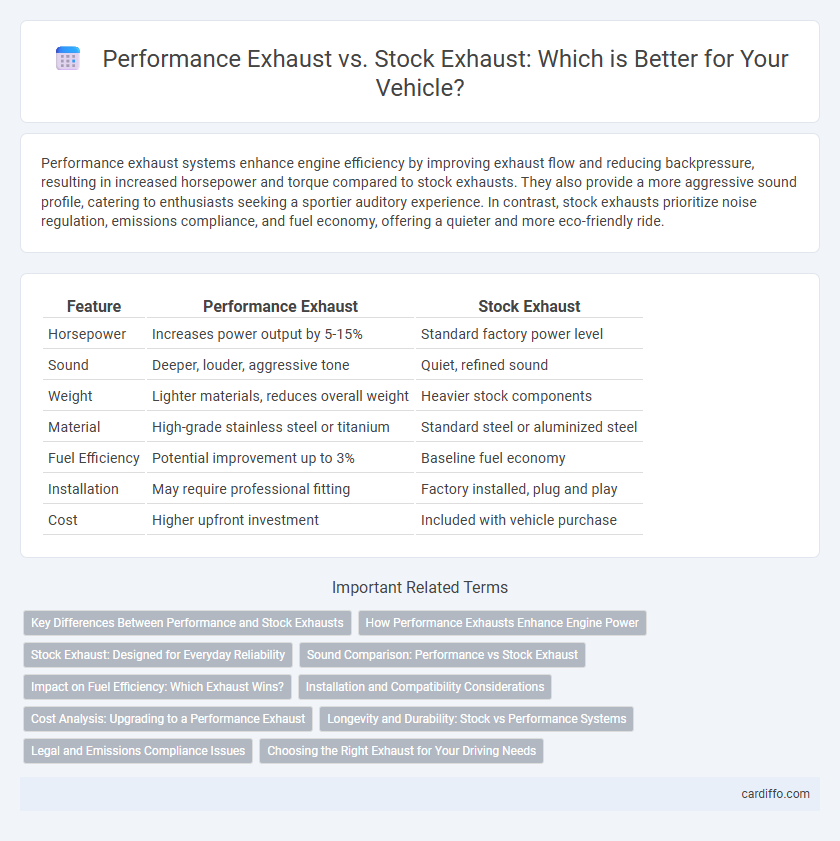Performance exhaust systems enhance engine efficiency by improving exhaust flow and reducing backpressure, resulting in increased horsepower and torque compared to stock exhausts. They also provide a more aggressive sound profile, catering to enthusiasts seeking a sportier auditory experience. In contrast, stock exhausts prioritize noise regulation, emissions compliance, and fuel economy, offering a quieter and more eco-friendly ride.
Table of Comparison
| Feature | Performance Exhaust | Stock Exhaust |
|---|---|---|
| Horsepower | Increases power output by 5-15% | Standard factory power level |
| Sound | Deeper, louder, aggressive tone | Quiet, refined sound |
| Weight | Lighter materials, reduces overall weight | Heavier stock components |
| Material | High-grade stainless steel or titanium | Standard steel or aluminized steel |
| Fuel Efficiency | Potential improvement up to 3% | Baseline fuel economy |
| Installation | May require professional fitting | Factory installed, plug and play |
| Cost | Higher upfront investment | Included with vehicle purchase |
Key Differences Between Performance and Stock Exhausts
Performance exhaust systems feature larger diameter pipes and mandrel bends that improve exhaust flow, resulting in increased horsepower and torque compared to stock exhausts. Performance exhausts typically use high-quality materials like stainless steel or titanium for enhanced durability and corrosion resistance, whereas stock exhausts often rely on cheaper metals prone to rust. Sound profile is a key differentiator, with performance exhausts delivering a deeper, more aggressive exhaust note, while stock systems are designed to minimize noise for compliance with regulations and comfort.
How Performance Exhausts Enhance Engine Power
Performance exhaust systems improve engine power by optimizing exhaust gas flow, reducing backpressure, and increasing horsepower and torque output. Upgraded materials and larger diameter piping in performance exhausts facilitate quicker expulsion of exhaust gases, allowing the engine to breathe more efficiently. Enhanced scavenging effects and improved turbo spool time contribute to overall improved engine responsiveness compared to stock exhaust setups.
Stock Exhaust: Designed for Everyday Reliability
Stock exhaust systems are engineered to provide consistent performance and durability for daily driving conditions, ensuring reliable engine function and compliance with emission standards. These exhausts prioritize noise reduction and fuel efficiency, maintaining a balance between comfort and operational cost. By using OEM materials and precise calibrations, stock exhausts offer long-term dependability without sacrificing vehicle warranty or regulatory requirements.
Sound Comparison: Performance vs Stock Exhaust
Performance exhaust systems produce a deeper, more aggressive sound compared to stock exhausts, enhancing the overall driving experience. Stock exhausts tend to be quieter and more refined, designed to minimize noise and comply with strict emissions standards. The amplified sound from a performance exhaust not only signals increased power but also provides better auditory feedback during acceleration.
Impact on Fuel Efficiency: Which Exhaust Wins?
Performance exhaust systems enhance fuel efficiency by improving exhaust flow and reducing backpressure, allowing the engine to operate more efficiently compared to stock exhausts. Studies show that vehicles equipped with performance exhausts can experience fuel economy improvements of up to 5-7% under optimal driving conditions. Stock exhausts prioritize noise reduction and emissions control, often resulting in slightly lower fuel efficiency than performance-oriented alternatives.
Installation and Compatibility Considerations
Performance exhaust systems often require precise installation techniques to ensure optimal fit and function, frequently involving modifications to existing components. Compatibility varies significantly across vehicle makes and models, demanding thorough research to avoid issues with mounting points, emissions compliance, and sensor integration. Selecting a performance exhaust that matches the vehicle's specifications streamlines installation and enhances overall driving dynamics without compromising warranty coverage.
Cost Analysis: Upgrading to a Performance Exhaust
Upgrading to a performance exhaust typically costs between $500 and $2,000, depending on the brand and material quality, compared to the stock exhaust which is included in the vehicle's initial purchase price. Performance exhaust systems improve engine efficiency and horsepower, potentially increasing fuel efficiency, which can offset initial costs over time. Labor expenses for professional installation range from $100 to $300, making the total investment significant but often justified by enhanced acoustic quality and vehicle resale value.
Longevity and Durability: Stock vs Performance Systems
Performance exhaust systems typically use high-quality materials such as stainless steel or titanium, enhancing corrosion resistance and overall longevity compared to stock exhausts made from lower-grade metals. Stock exhaust systems generally offer adequate durability for everyday driving but may degrade faster under high-stress conditions due to thinner materials and standard coatings. Investing in a performance exhaust often results in a longer-lasting, more resilient system that withstands heat and environmental factors better than factory-installed units.
Legal and Emissions Compliance Issues
Performance exhaust systems often face stricter legal scrutiny compared to stock exhausts due to increased noise levels and altered emissions outputs, which can violate local regulations and result in fines or vehicle inspections failure. Stock exhausts are designed to comply with federal and state emissions standards, ensuring vehicles meet Environmental Protection Agency (EPA) requirements and maintain proper catalytic converter function. When upgrading to a performance exhaust, it is crucial to verify compliance with the Clean Air Act and ensure that the system is CARB (California Air Resources Board) approved in applicable regions to avoid legal and environmental penalties.
Choosing the Right Exhaust for Your Driving Needs
Performance exhaust systems deliver increased horsepower, improved throttle response, and a more aggressive sound, making them ideal for drivers seeking enhanced acceleration and track capabilities. Stock exhausts typically provide quieter operation, better fuel efficiency, and compliance with emissions standards, suiting daily commuting and long-distance driving. Selecting the right exhaust depends on prioritizing either power and sound or fuel economy and noise regulations to match your specific driving style and environment.
Performance exhaust vs stock exhaust Infographic

 cardiffo.com
cardiffo.com